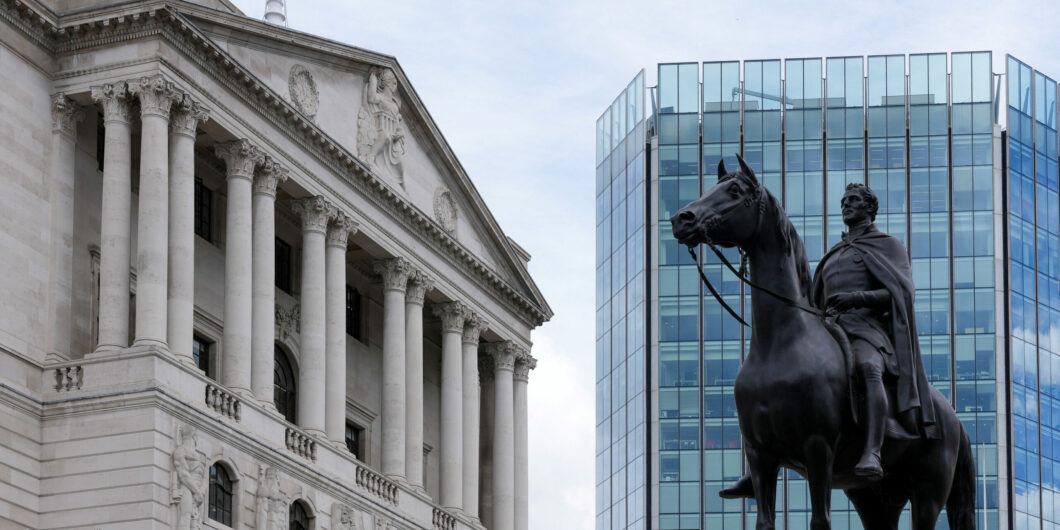The Old Lady of Threadneedle Street
History may often be treated as the story of great men, but institutions also have much to tell. Effective ones provide leverage to act more effectively, and seeing how they work is critical to understanding their success. The Bank of England, for example, facilitated Britain’s eighteenth-century rise as a great power. Founded in July 1694 as a private organization responsible to shareholders, it was a key component in what the historian John Brewer called the “fiscal-military state” developed to finance war through a national debt serviced by specifically designated tax revenues. Since reliable payment made government debt a good investment, Britain could borrow larger amounts on more favorable terms than its rivals to pay the massive expense of naval fleets along with the army and subsidies to allies fighting alongside them. In addition to fostering London’s growth as a commercial center, the system gave debt holders, contractors selling to government, and those employed to collect and transfer revenue a financial stake in Hanoverian Britain that encouraged them to support the status quo. A private enterprise that Adam Smith also called “a great engine of state,” the Bank of England had a pivotal role in that system as a contracted agent outside the British government. Its position allowed a flexibility that delivered efficiencies bureaucracy rarely provides. The result extended the British state’s capacity to act while fostering trade and growth.
Often called “the Old Lady of Threadneedle Street” from the title of a satirical print by James Gillray in 1797, the Bank of England’s London infrastructure changed significantly over its history. Seeing the bank as it operated during the mid-1700s period of growth requires a leap of imagination along with considerable research. Anne Murphy deftly pieces together a picture in Virtuous Bankers: A Day in the Life of the Eighteenth-Century Bank of England, bringing into focus its larger role. Records from a Committee of Inspection established in March 1783 by three of the bank’s directors enable her to recreate how clerks transacted its business along with what functions occurred where in its sprawling offices. The inquiry sprang from concerns over the reliability of employees on whom so much depended. Trust in them was key to upholding confidence in an institution that had become the guardian of public credit and a vital facilitator of so much else. Murphy likens the Bank’s work to an industrial process “requiring specific equipment, spaces, and skills; time defined; specialized and coordinated.” Tracing those activities through a typical day with plans of the building and images of its interior gives her an opening to discuss important aspects of Britain’s eighteenth-century economy and the commercial culture it sustained.
The bank’s offices in the old City of London stood across from the Royal Exchange and near Exchange Alley where stock trading occurred. Moving to Threadneedle Street, a major thoroughfare by commercial and shopping districts and other areas where financiers had long operated, had brought it closer to the East India and South Companies premises. Being in the middle of the action made for bustle. Since the headquarters could not accommodate the increased business, the bank started an expansion program to acquire nearby land and build additional facilities that included a large domed Rotunda or Brokers’ Exchange to bring the market for government debt onto its premises. Murphy describes the outside façade in Portland Stone, designed to impress the public and British state by its contrast with smaller brick structures nearby. The volatile spirit of Credit, a female allegory complementing Britannia, served as a potent symbol in a heavily trafficked public or quasi-public space.
Porters responsible for monitoring public access scurried to clean rooms and prepare for the 9 a.m. opening. Out-tellers, later called bank messengers, departed early for customers’ premises to negotiate bills due. Their work began the previous day with clerks sorting bills and listing them for collection. Besides the risk of carrying valuable paper outside the bank perimeter, they needed the skill to recognize forgery and understand common means of exchange. The work took several hours each morning, sometimes with several stops. Clerks at the bank provided cashier services for the government by issuing notes and lesser amounts in cash (i.e. coined money) on Exchequer bills. Doing so facilitated the business of revenue collection and paying contractors and suppliers. Before opening, in-tellers had collected from storage bank notes expected to be needed that day. Duplicate records of stock debt transfers returned from safekeeping at a director’s home.
The Banking Hall with its desks for cashiers and tellers and passage to the Cashier’s Office was a focal point for gathering information as well as transacting business. Mornings to mid-afternoon drew a large crowd of merchants and financiers who valued the face-to-face interactions the daily routine provided. Murphy emphasizes how the Banking Hall provided a site for polite sociability that served what Montesquieu called the civilizing function of commerce. Its business of taking deposits, issuing notes, and making loans reduced transaction costs to facilitate both the exchange of goods and services and revenue collection. Bank of England notes operated as a form of credit advanced on the government’s account and then endorsed by the state using or accepting them in payment. Discounting or lending money against promissory notes and bills of exchange served the wider economy while generating regular profits for the bank. Murphy notes that as the bank became the largest discounter by the late eighteenth century, it acquired the power to act as a lender of last resort that even the British state did not enjoy. The bank’s independence from government control or parliamentary oversight made trust in its officials all the more vital as its business grew.
Murphy’s inside account of the Bank of England shows how history comprises the story of great institutions alongside great individuals.
Trade in government stocks and bank shares opened in the Rotunda at 11 a.m. and the transfer desks where clerks recorded trades closed at 1 p.m. The circular space, Murphy writes, left participants free to occupy it “as they wished rather than taking up fixed positions as they did in other market environments.” She again stresses the informal and personal contacts that occurred with the Rotunda providing a site for observation as well as action. The noise of trading and the body language of participants conveyed information on the state of the markets. Britain’s government contracted with the bank to manage both initial offers on its debt and transfers in the secondary market. While initial offerings were done by tender and favored insiders, secondary trades were done on the open market. Ordinary creditors participated at various levels as well as brokers and jobbers. Government debt was an increasingly safe investment that appealed to the risk-averse, and Murphy notes the small purchasers building a nest egg for eventual retirement. Operating in a public space brought scrutiny that, as Adam Smith recognized, held dishonest brokers to account with participants imposing restraints on each other. Markets had checks and balances of their own without necessarily relying on supervision by authorities.
Work slowed by late afternoon, with clerks turning to issue dividend warrants that required confirming who owned shares for which they would be paid. Notaries visited to inspect accounts held by overseas customers with managing an important back-office function Murphy uses to discuss the bank’s administration. Keeping employees honest and attentive to their duty was a serious concern. By evening, the bank would be moving to close operations while preparing for the next day’s start.
The Bank of England’s role as the country’s dominant financial institution by the mid-eighteenth century operated in growing tension with how it provided a market for public debt that critics accused of exploiting the naïve and manipulating wartime pressures on public finance for private profit. Fears of corruption shaped eighteenth-century public culture in Britain by fueling anxieties stoked by the press. Efforts to separate the bank’s management of public credit from its trading of government debt aimed to resolve the conflict of interest. Overseeing activities behind the scenes, especially record-keeping and personnel, also became a concern behind the 1783 inquiry on which Murphy bases most of her account. Besides upholding public confidence and curtailing inefficiency and expense, the directors behind it sought to keep the bank from the kind of oversight parliament imposed on the East India Company. Private enterprises whose operations affected the interests of the British state and those of many individuals who could not be ignored had to justify their independence by showing themselves worthy of it.
Directors had to protect the bank from more than internal malfeasance and political moves to curtail its independence. Fire was a concern from the start. Hence the need to keep duplicate records offsite. Its gold and notes also made the bank and its employees targets for theft. Riots posed another danger. Britain lacked a police force until the 1820s and the bank relied on its own armed watchmen. Soldiers came to its defense in the Gordon Riots of 1780 and troops from the Foot Guards would later be stationed regularly. Capturing the Bank of England’s treasure, like the Tower of London with its arms cache, became the plan of radical conspiracies into the nineteenth century.
Murphy writes that the Committee of Inspection found a dedication to public service among employees, procedures that largely worked effectively, and overall a business capable of meeting its responsibilities. Some faults, like clerks accepting gratuities from customers, persisted, but others were addressed and changes improved security. Their efforts also provide a revealing window into how the bank worked that highlights its importance to the eighteenth-century economy. How institutions operate and what they do can reveal as much about them as exploring an individual’s personality. Institutions, like architecture and geography, set the context and parameters for action, but they also develop mentalities and imperatives of their own that make their workings a window onto important trends. The bank’s effectiveness as a government agent rested on the virtue of its personnel as much as its efficient operation. Murphy’s inside account of the Bank of England shows how history comprises the story of great institutions alongside great individuals.



